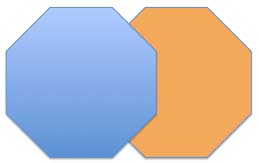Learn how you can intersect shapes in PowerPoint 2011 for Mac. The Shape Intersect command combines selected shapes that overlap each other, and removes everything else.
Author: Geetesh Bajaj
Product/Version: PowerPoint 2011 for Mac
OS: Mac OS X
PowerPoint 2011 for Mac allows you to take any of the shapes you create. You can then, use Combine, Union, Intersect, or Subtract commands to create your own new shape out of them. Play around with these commands to indulge in endless hours of fun, but be careful not to be addictive. In this tutorial, you will see how you can take two or more shapes and intersect them to end up with interesting results. For example, we placed two basic shapes over a square (three shapes in all) as shown towards the left of Figure 1, below. With these shapes selected, we could use the Intersect command that is explained later in this tutorial to create a unified, intersected shape as shown towards the right in Figure 1. This new shape only retains those areas where all the three shapes were intersecting each other.

Figure 1: Sample showing the use of the Shape Intersect command
Once you finish reading this tutorial, do view the sample presentations embedded on the bottom of this page to see more samples of shapes created using the Intersect command:



Here’s how the Intersect command behaves in various scenarios:
You will see these guidelines in use within the embedded presentations below (scroll down this page).
The sample presentations below show how we used different shapes placed next to and above each other, and then intersected.
Click below to view this presentation on SlideShare
Click below to view this presentation on YouTube
See Also:
Merge Shapes: Shape Intersect Command in PowerPoint (Index Page)
Shape Intersect Command in PowerPoint 2016 for WindowsYou May Also Like: Morph in PowerPoint: Conversation with Lauren Janas | Student PowerPoint Templates




Microsoft and the Office logo are trademarks or registered trademarks of Microsoft Corporation in the United States and/or other countries.